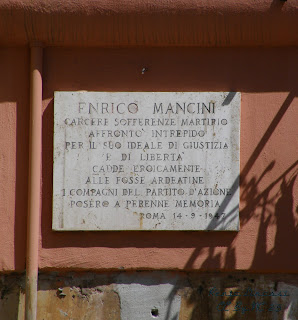(English) War memorial, in the form of a plaque, devoted to the soldiers coming from the borough of Monti that fallen during First World War. The plaque is placed on the outside wall the church of Santa Maria Madonna dei Monti, at 41 of the namesake street.
It's beside a street cleansing plaque, and in nearness of the plaque devoted to Nazario Sauro. This plaque has no date of building, but it's probably on of the later in Rome, erected after 1921, when fascist symbolism started to spread. The monument is made in travertine, the typical roman construction stone, with a inner marble plaque (made of two parts).
The plaque is mounted with a pediment, in the tympanum the head of a soldier with the Model 16 helmet.
Under, three fasces mounted with three eagles, quintessence of fascist style. The fasces and the eagles divide the upper plaque in three part: in every part an upright inscription: MCMXV, MCMXVIII, +SPQR; the dates of the begin and the end of the war (for Italy), and the city of Rome motto. Notable, the axes in the fasces are mounted with a warrior head (probably a roman legionary), instead of a lion head, that late became a standard for fascist fasces.
In the lower part three squares, with inscripted three "peaks" (or "hillocks") for each, a recall to borough coat of arms. The Rione Monti coat of arms is D'argento ai tre monti di tre cime di verde, of silver with three mounts with three peaks, following the heraldry definition; or rahter a silver shield with 3 mounts, each of 3 peak. In the War Memorial the shape of each peak is like a bullet. Fasces, eagles and mounts make a frame for the inner plaque. In the upper part the dedication from the inhabitant of the borough. Under, first the name of second lieutenant Carlo Mazzaresi, Golden Medal of Military Value, and under three columns of names: in order of rank and following in alphabetical order.
In the lower side of travertine frame was added, probably in a second time, three columns of fours name each. These names are not well preserved and difficult to read. Remarkable, in the frame lower right angle is the name of the architect that (probably) designed the plaque, Oriolo Frezzotti. Sculptor and architect he's famous for the city of Littoria, now Latina, town plan.
Ideally this plaque marks the zenith of the style evolution for the War Memorial, from the pre-war style like in the plaque for the Fallen of Appio-Latino-Tuscolano, trough the strong symbolism, but without fascist elements, like Trastevere, reaching the fascist style in Monti.
Here a translation of the plaque inscription (Monticiani is name of the borough inhabitants):
It's beside a street cleansing plaque, and in nearness of the plaque devoted to Nazario Sauro. This plaque has no date of building, but it's probably on of the later in Rome, erected after 1921, when fascist symbolism started to spread. The monument is made in travertine, the typical roman construction stone, with a inner marble plaque (made of two parts).
The plaque is mounted with a pediment, in the tympanum the head of a soldier with the Model 16 helmet.
Under, three fasces mounted with three eagles, quintessence of fascist style. The fasces and the eagles divide the upper plaque in three part: in every part an upright inscription: MCMXV, MCMXVIII, +SPQR; the dates of the begin and the end of the war (for Italy), and the city of Rome motto. Notable, the axes in the fasces are mounted with a warrior head (probably a roman legionary), instead of a lion head, that late became a standard for fascist fasces.
In the lower part three squares, with inscripted three "peaks" (or "hillocks") for each, a recall to borough coat of arms. The Rione Monti coat of arms is D'argento ai tre monti di tre cime di verde, of silver with three mounts with three peaks, following the heraldry definition; or rahter a silver shield with 3 mounts, each of 3 peak. In the War Memorial the shape of each peak is like a bullet. Fasces, eagles and mounts make a frame for the inner plaque. In the upper part the dedication from the inhabitant of the borough. Under, first the name of second lieutenant Carlo Mazzaresi, Golden Medal of Military Value, and under three columns of names: in order of rank and following in alphabetical order.
In the lower side of travertine frame was added, probably in a second time, three columns of fours name each. These names are not well preserved and difficult to read. Remarkable, in the frame lower right angle is the name of the architect that (probably) designed the plaque, Oriolo Frezzotti. Sculptor and architect he's famous for the city of Littoria, now Latina, town plan.
Ideally this plaque marks the zenith of the style evolution for the War Memorial, from the pre-war style like in the plaque for the Fallen of Appio-Latino-Tuscolano, trough the strong symbolism, but without fascist elements, like Trastevere, reaching the fascist style in Monti.
Here a translation of the plaque inscription (Monticiani is name of the borough inhabitants):
TO THE BRAVES MONTICINANI
FALLEN IN THE WORLD WAR
GRANTS GOD ETERNAL GLORY
(WE) PROMISE UNENDING TRIBUTE
OF LOVE AND DESERVING DEEDS
WE THAT RISED TO A NEW LIFE
WITH THE ITALY REGENERATE
BY THE BLOOD OF ITS BETTER SONS
FALLEN IN THE WORLD WAR
GRANTS GOD ETERNAL GLORY
(WE) PROMISE UNENDING TRIBUTE
OF LOVE AND DESERVING DEEDS
WE THAT RISED TO A NEW LIFE
WITH THE ITALY REGENERATE
BY THE BLOOD OF ITS BETTER SONS
 | |
(Italiano) Monumenti ai caduti, in forma di lapide, dedicato ai soldati del Rione Monti, caduti nella prima guerra mondiale. La lapide è posta sul muro esterno della chiesa di Snata Maria Madonna dei Monti, al numero 41 della via omonima.
La targa è a fianco di una lapide di pulizia delle strade, nelle vicinanze di una targa in memoria di Nazario Sauro.
La targa non ha data di installazione, ma è probabilmente una delle ultime erette a Roma, dopo il 1921, quando il simbolismo fascista iniziò a diventare una costante.
Il monumento è fatto di travertino, la tipica pietra da costruzione romana, con una targa interna in marmo (targa composta in due parti). Sormontata da un frontone, nel timpano triangolare la testa di un soldato, con l'elmetto modello 16.
Al di sotto tre fasci, montati da tre aquile, quintessenza dello stile fascista. Aquile e fasci dividono la parte superiore del monumento in 3 parti: in ogni parte un'iscrizione: MCMXV, MCMXVIII, + SPQR; le date d'inizio e fine della guerra (per l'Italia), ed il motto della città di Roma. È da notare come le asce nei fasci siano montate da una testa di guerriero (probabilmente un legionario romano), anziché da una testa di leone, più tardi standard per i fasci fascisti.
Nella parte inferiore tre riquadri, con iscritti ciascuno 3 "cime", un richiamo allo stemma del Rione: D'argento ai tre monti di tre cime di verde. La forma delle cime nel monumento ai caduti ricorda quella di un proiettile.
Fasci, aquile e monti formano la cornice per la targa interno. Nella parte superiore la dedica degli abitanti del quartiere. Al di sotto, prima il nome di Carlo Mazzaresi, Medaglia d'oro al Valor Militare; al di sotto 3 colonne di nomi: in ordine di grado e, a seguire, alfabetico. Nella parte inferiore della cornice di travertino sono stati aggiunti, probabilmente in un secondo tempo. 3 colonne di 4 nomi ciascuno. Iscrizioni non ben preservate e difficili da leggere. Particolare, nell'angolo in basso a destra il nome dell'architetto che (probabilmente) progettò la targa, Oriolo Frezzotti. Scultore ed architetto famoso per il Piano regolatore della città di Littoria, oggi Latina.
Idealmente questa targa segna l'apice dell'evoluzione dello stile dei monumenti ai caduti, dallo stile quasi anteguerra di targhe come quella dell'Appio-Latino-Tuscolano, passando a quello carico di simboli, ma privo di elementi chiaramente fascisti come a Trastevere, si arriva allo stile fascista come a Monti.
La targa è a fianco di una lapide di pulizia delle strade, nelle vicinanze di una targa in memoria di Nazario Sauro.
La targa non ha data di installazione, ma è probabilmente una delle ultime erette a Roma, dopo il 1921, quando il simbolismo fascista iniziò a diventare una costante.
Il monumento è fatto di travertino, la tipica pietra da costruzione romana, con una targa interna in marmo (targa composta in due parti). Sormontata da un frontone, nel timpano triangolare la testa di un soldato, con l'elmetto modello 16.
Al di sotto tre fasci, montati da tre aquile, quintessenza dello stile fascista. Aquile e fasci dividono la parte superiore del monumento in 3 parti: in ogni parte un'iscrizione: MCMXV, MCMXVIII, + SPQR; le date d'inizio e fine della guerra (per l'Italia), ed il motto della città di Roma. È da notare come le asce nei fasci siano montate da una testa di guerriero (probabilmente un legionario romano), anziché da una testa di leone, più tardi standard per i fasci fascisti.
Nella parte inferiore tre riquadri, con iscritti ciascuno 3 "cime", un richiamo allo stemma del Rione: D'argento ai tre monti di tre cime di verde. La forma delle cime nel monumento ai caduti ricorda quella di un proiettile.
Fasci, aquile e monti formano la cornice per la targa interno. Nella parte superiore la dedica degli abitanti del quartiere. Al di sotto, prima il nome di Carlo Mazzaresi, Medaglia d'oro al Valor Militare; al di sotto 3 colonne di nomi: in ordine di grado e, a seguire, alfabetico. Nella parte inferiore della cornice di travertino sono stati aggiunti, probabilmente in un secondo tempo. 3 colonne di 4 nomi ciascuno. Iscrizioni non ben preservate e difficili da leggere. Particolare, nell'angolo in basso a destra il nome dell'architetto che (probabilmente) progettò la targa, Oriolo Frezzotti. Scultore ed architetto famoso per il Piano regolatore della città di Littoria, oggi Latina.
Idealmente questa targa segna l'apice dell'evoluzione dello stile dei monumenti ai caduti, dallo stile quasi anteguerra di targhe come quella dell'Appio-Latino-Tuscolano, passando a quello carico di simboli, ma privo di elementi chiaramente fascisti come a Trastevere, si arriva allo stile fascista come a Monti.
AI PRODI MONTICIANI
CADVTI NELLA GVERRA MONDIALE
CONCEDA GLORIA ETERNA IDDIO
PROMETTIAMO TRIBUTO PERENNE
DI AMORE E DI OPERE DEGNE
NOI CHE SORGEMMO A NVOVA VITA
CON L'ITALIA RIGENERATA
DAL SANGVE DEI MIGLIORI SVOI FIGLI
S.TEN.MAZZARESI CARLO MEDAGLIA D'ORO
CADVTI NELLA GVERRA MONDIALE
CONCEDA GLORIA ETERNA IDDIO
PROMETTIAMO TRIBUTO PERENNE
DI AMORE E DI OPERE DEGNE
NOI CHE SORGEMMO A NVOVA VITA
CON L'ITALIA RIGENERATA
DAL SANGVE DEI MIGLIORI SVOI FIGLI
S.TEN.MAZZARESI CARLO MEDAGLIA D'ORO
| MAGG. | ROMANO LORENZO | SERG. | SONGINI MARIANO | SOLD. | FLERES SALVATORE |
| CAP. | DE GAETANI ENRICO | " | VARRONI NICOLA | " | FONTANA ROMOLO |
| " | FANTI FILIPPO | CAP.M. | ROSSI CHERUBINO | " | GABRIOTTI LVUIGI |
| " | PANDOLFI GIOVANNI | " | ROSSI LVUIGI | " | GASPERI VMBERTO |
| " | PELLI EGISTI GLOTTO | CAP. | AMORE VINCENZO | " | GHINI TVLLIO |
| TEN. | ALESSANDRI LVIGI | " | BEVIGNANI ANTONIO | " | GIGANTI AGOSTINO |
| " | AMMILLERI GIVLIO | " | CREMONA CARLO | " | GRILLI GIVSEPPE |
| " | AVOGADRO GIVSEPPE | " | ESPOSITO LVIGI | " | GVIDOBALDI CVRZIO |
| " | BINOTTI AMEDEO | " | MAGRINI GVIDO | " | LOMBARDOZZI ANTONIO |
| " | DOTTARELLI PIETRO | " | TERZI GIVSEPPE | " | LVCARELLI BRVNO |
| " | LADELCI PIO | SOLD. | ALIMENTI ESPARTERO | " | LVNGHI DOMENICO |
| " | PORZIOLI ANGELO | " | ALTISSIMI VMBERTO | " | MANFRONI RENATO |
| " | ROSSI ALBERTO | " | ALVITI GIVSEPPE | " | MARCHETTI RINALDO |
| " | RAPI CESARE | " | AMICI DOMENICO | " | MISELLI GIOVANNI |
| S.TEN. | AMILLERI GIVSEPPE | " | ANGELINI MARCO | " | NARDONI SILVIO |
| " | BELARDI VIRGILIO | " | AVERSI VMBERTO | " | NECCI FEDERICO |
| " | CAMILLETTI VGO | " | BALDASSARI MARIO | " | OTTAVIANI ANGELO |
| " | CVRTI LVUIGI | " | BASSI ANTONIO | " | PASQVALI ARRICO |
| " | MVULLER PASQVALE | " | BATTARELLI FAVSTO | " | PEDVSSIA VITTORIO |
| " | PIEROTTI FERDINANDO | " | BENIGNI DESIDERIO | " | PICCHI-GOLVCCI GIOV. |
| " | ROSSELLI VMBERTO | " | BOZZI MARIO | " | PILOZZI ALFREDO |
| " | SCOCCHI ARMANDO | " | BRVSTIO VMBERTO | " | RASTELLINI PIETRO |
| " | STRAMIGGIOLI ITALO | " | CANOFANI ATTILIO | " | RIPANTI FERNANDO |
| " | VACCARI VGO | " | CARDINALI MARIANO | " | ROMITI CESARE |
| ASP. | BOFFI LAMBERTO | " | CETRONI CESIDIO | " | ROSSI DOMENICO |
| " | MAGAGNOLI GOFFREDO | " | CINQVE FRANCESCO | " | RVGGERI ETTORE |
| " | SAMPOLI VMBERTO | " | CIROTTI LVIGI | " | SCARPETTI CESARE |
| SERG.M. | ANGELONI GIOVANNI | " | COCCIA ANGELO | " | STECCHIOTTI GIVSEPPE |
| " | BERNI MICHELE | " | COCCIA AVGVSTO | " | TEMPORINI NICOLA |
| SERG. | BERANGER RENATO | " | CONFORTI RAFFAELLO | " | TESORI NAZZARENO |
| " | CARDAMINI ROBERTO | " | CVCODORO GAETANO | " | TROMBETTA MARIO |
| " | CAPELLI GVUGLIELMO | " | D'AMBROSI ORAZIO | " | TRIMA ANTONIO |
| " | GENNARI ROMEO | " | DE BERNARDIS PAOLO | " | VGHI MARIO |
| " | GIGLI RENATO | " | DELLA ROVERE OTELLO | " | VICHI ROMOLO |
| " | GVARDUCCI TOMMASO | " | DE ROSSI ERNESTO | " | ZANNONI NORBERTO |
| " | PEROTTI ARMANDO | " | ELISEO RAFFAELE | " | ZANNOTTI FRANCESCO |
| " | PERVGINI ANTONIO | " | EVANGELISTI ROMOLO | " | BIANCHINI ERNESTO |
| " | SCALZAFERRI VINCENZO | " | FIORI CESARE | " | MONTANI FERNANDO |
| TEN. | DEL BVTTERO RENATO | " | CASTELLINI MARIO | " | MONTANI ITALO |
| S.TEN. | DEL BVTTERO GINO | " | ANDREOTTI RAFFAELE | " | BVCCIOLI LVIGI |
| " | DE MORI ALESSANDRO | CAP-M | BISSATTINI FELICE | S.TEN. | CASAPIETRA UMBERTO |
| " | RICCIONI GIOSAFAT | SOLD. | LVPACCINI COLOMBO | ||
| AIV.D.BAT | D'ALENA GIVSEPPE | ||||
| TEN | STETTINER TORQVATO | ||||
| S.TEN | COMPAGNA PIETRO | SOLD. | GENTILI MARIO | SOLD. | MARFANI VIRGILIO |
| " | GARGIVLO GIVLIO | GIACOMELLI VITTORIO | IANELLA GVSTAVO | ||
| CAP. | MANCINI LVIGI | GIVNTI ROMOLO | STEFFOLANI ROMOLO | ||
| EN. | BAMBINI LVIGI | IGHILI VITTORIO | GALLETTI NVLLO | ||
| ARCH O FREZZOTTI |




